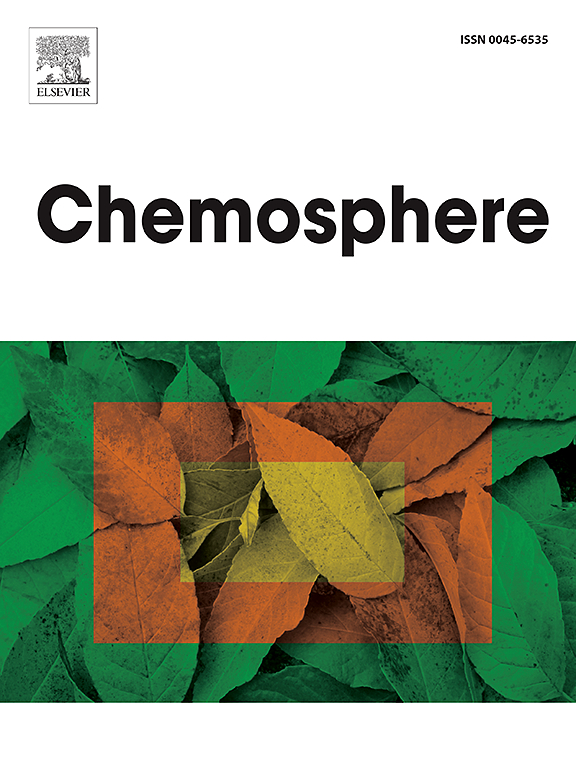Metabolomics identified distinct molecular-level responses in Daphnia magna after exposure to phenanthrene and its oxygen and nitrogen containing analogs
IF 8.1
2区 环境科学与生态学
Q1 ENVIRONMENTAL SCIENCES
引用次数: 0
Abstract
The prevalence of polycyclic aromatic hydrocarbons and their oxygenated and nitrogen containing analogs in freshwater ecosystems are of concern due to their reported toxicity to several aquatic species including Daphnia magna. This study explored the molecular-level responses of phenanthrene (PHEN), 9,10-phenanthrenequinone (PHQ), and phenanthridine (PN) as little is known about the impacts of these pollutants on the metabolic profile of D. magna. For this purpose, D. magna was exposed to three sub-lethal concentrations of these pollutants for 24 h. To assess molecular-level responses, 52 polar metabolites were extracted from individual adult daphnids, and analyzed using a mass spectrometry-based targeted metabolomics approach. Exposure to PN resulted in the most statistically significant changes to the metabolic profile of D. magna followed by PHQ, and then PHEN exposures. After PN exposure, the biochemical pathway analysis showed that all exposure concentrations shared 21 perturbed metabolic pathways. However, the number of disrupted metabolic pathways increased with increasing exposure concentrations for PHEN and PHQ. The results suggest that PN and PHQ exposures are more disruptive due to the presence of reactive functional groups when compared to PHEN exposure. For the tested concentration ranges, the findings indicate that exposure to PN resulted in non-monotonic disruptions across exposure concentrations. In contrast, exposure to PHEN and PHQ elicited perturbations that were concentration-dependent. Although the reported median effective concentration (EC50) for PN is higher than PHEN and PHQ, our data shows that metabolomics captures molecular-level changes that may not be detected by traditional toxicity metrics.

代谢组学鉴定了大水蚤暴露于菲及其含氧和含氮类似物后的不同分子水平反应
多环芳烃及其含氧和含氮类似物在淡水生态系统中的普遍存在受到关注,因为它们对包括大水蚤在内的几种水生物种具有毒性。本研究探讨了菲(PHEN), 9,10-菲醌(PHQ)和菲百啶(PN)的分子水平响应,因为这些污染物对D. magna代谢谱的影响知之甚少。为此,研究人员将D. magna暴露在三种亚致死浓度的污染物中24小时。为了评估分子水平的反应,从成年水蚤个体中提取了52种极性代谢物,并使用基于质谱的靶向代谢组学方法进行了分析。暴露于PN对D. magna代谢谱的影响最显著,其次是PHQ,然后是PHEN。在PN暴露后,生化途径分析显示所有暴露浓度共有21条代谢紊乱途径。然而,随着PHEN和PHQ暴露浓度的增加,被破坏的代谢途径的数量增加。结果表明,与PHEN暴露相比,PN和PHQ暴露由于活性官能团的存在而更具破坏性。对于测试的浓度范围,研究结果表明,暴露于PN会导致不同暴露浓度的非单调破坏。相比之下,暴露于PHEN和PHQ引起的扰动是浓度依赖性的。尽管报道的PN的中位有效浓度(EC50)高于PHEN和PHQ,但我们的数据表明,代谢组学捕获了传统毒性指标可能无法检测到的分子水平变化。
本文章由计算机程序翻译,如有差异,请以英文原文为准。
求助全文
约1分钟内获得全文
求助全文
来源期刊

Chemosphere
环境科学-环境科学
CiteScore
15.80
自引率
8.00%
发文量
4975
审稿时长
3.4 months
期刊介绍:
Chemosphere, being an international multidisciplinary journal, is dedicated to publishing original communications and review articles on chemicals in the environment. The scope covers a wide range of topics, including the identification, quantification, behavior, fate, toxicology, treatment, and remediation of chemicals in the bio-, hydro-, litho-, and atmosphere, ensuring the broad dissemination of research in this field.
 求助内容:
求助内容: 应助结果提醒方式:
应助结果提醒方式:


